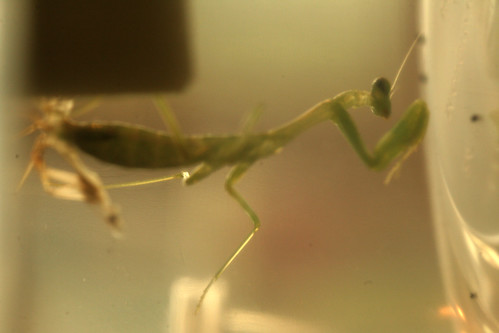superfreak, I know that's not what was going on with your late mantis. The picture is a response to a side discussion between posts #10 thru #14 about the mechanism that allows a mantis to compress liquid or air, and where the space or organ may be to do so.
Yeah, we really should do this swelling thing, because there is a nice, well known cause. So for once, a sensible question can have a reasonable answer.
Insect "blood" or hemolymph performs many of the functions of blood, but instead of being contained in a closed vascular system, it bathes the insect's organs. Like air in a balloon, it also exerts pressure on the exoskeleton, and where that is thin, typically in the abdomen, keeps it more or less turgid. It is capable of exerting a wide range of pressure. I don't know about mantids, but in the housefly, it can increase fivefold (that's like yr systolic B/P going from 120 to 600mm/Hg!) Pressure is increased or decreased according to the insect's water and/or air intake through the mouth. Here: This is the best Internet treatment of the insect's circulatory system that I know:
http://www.cals.ncsu.edu/course/ent425/tut...irculatory.html
I don't think that this increased hemolymph pressure against a moulting mantid's new, soft skin would do much to help ecdysis, though. The only molting action that I can think of, is contraction and relaxation of the abdominal muscles to help work the old skin loose. Certainly, too much pressure of the new skin against the old would make shedding of the latter more difficult. Once the old skin is gone, though, the new skin maintains its integrity while it hardens due to the internal pressure exerted by the hemolymph. A second function of this increased pressure is to fill the wing veins after eclosure, which is one reason why I tend to favor an environmental explanatin for your "crumpled wing" mantids.
I think that that accounts for the abdominal swelling of your mantids immediately after ecdesis, and the return to normal thereafter, but another environmental condition may affect the wing problem. Environmetally, the onset of ecdysis tends to be governed by photoperiod. In the wild, (and often in our pots) the mantis normally molts under the cover of darkness, when its period of vulnerability is less likely to allow its being eaten. At night, higher ambient humidity also tends to decrease. It is a fairly common sight to see newly emerged insects such as butterlies "pumping their wings" first thing in the morning as the sun catches them (well, it is if you get outside early enough

). In bug rooms, where we often work with the lights on way too late (right Katt?) that rhythm is disrumpted and may adversly affect the process. Perhaps it is also worth noting that there is no experimental evidence (unless someone just snuck some past me!) to demonstrate that increased ambient humidity facilitates ecdysis.
So there you go. The part about hemolymph pressure mechanism is pretty much text book stuff, though I'm sorry to say that I didn't find anything very useful on the internet, though you may find something useful to show us. The rest is more speculative, but I don't think that it contradicts any known facts.
I hope that this may be of some help.
HaHa! After sending this, I went back to the URL above to do a self-test and came across another great discussion, athttp://www.cals.ncsu.edu/course/ent425/library/tutorials/internal_anatomy/molting.html on the hormonal cycle that produces ecdysis. At the top of the article, there is what I, in my computer-illiterate way, thought was one of the worst graphs I have ever seen.Then I found that it is deliberately incomplete and that you have to hover over each of the colored enzymes in order to see its place in the cycle! Now all I have to do is copy the graph and name all the bits! What fun!

